 |
MICRO The 6502 JournalPublished by Robert M. Tripp, The Computerist |
 |
Best of MICRO 1 |
 |
Best of MICRO 2 |
 |
Best of MICRO 3 |

About small SBC systems

 |
MICRO The 6502 JournalPublished by Robert M. Tripp, The Computerist |
 |
Best of MICRO 1 |
 |
Best of MICRO 2 |
 |
Best of MICRO 3 |
 |
KIM-1/6502 User Notes is a publication about the KIM-1, slowly evolving to other 6502 systems like SYM-1 and AIM 65. Editor was the famous Eric Rehnke. After issue 17 it merged with Compute II. |
KIM-1 / 6502 USER NOTES INDEX BY SUBJECT VOLUME 1(Issues 1 till 6)
APPLICATIONS FOR KIM GENERAL INFORMATION
Application suggestions 1 Correction To Memory Map -------- 2
Calculator--Interface 4 Defective 6502 chips------------- 3
Interface 6 Discussion of Memory Allocation - 5
--T.I.5050 5 DISPLAY (on board)
Chess Clock Program 4 red filter for-----------------5
CONTROLLING Use of------------------------------1,5
--- Function Generator 1 EXPANSION OF SYSTEM
--- Light Intensity 4 KIMSI--------------------------4
--- Motor Speed 4 MEMORY
--- Touch tone encoder 1 Adding memory to KIM-1--------5
Degree Dispatch Computer 5 Diagnostic------------------- 2,5
Frequency Counter 3 Expansion---------------------4,3
OSI Memory-------------------------3
GAMES Using SD Sales 4K RAM Board 3
Bagels----------------- 5 Hardware tips
Battleship--------------6 Packaging KIM-1 --------------- 6,3
Horserace-------------- 3 Power Supply for KIM ---------- 4
Hunt the Wampus-------- 2 Red Filter for Display----------5
Jotto------------------ 5 INTERVAL TIMERS :
Kimmaze---------------- 4 The Other Timer-----------------2
Microchess------------- 3 and cassette 2
Mastermind------------- 5 Use Of--------------------------5,5
Moon Lander-----------1,3 MIKIM------------------------------5
HEDEX Program 1 OPERATION TIPS
MATH TEST Program 4 Using SST ---------------------2
Mini-l Loran-c 6 Using ST to start programs----4
MUSIC:KlugeHarp 3,2,6,6 Page 1 Programming Problems--------6
Real Time Clock 4, 5 Packaging your KIM-1---------------3
Square wave generator 5 Power Supply-----------------------4
Stopwatch Program 2 Presetting 00F1, 00F2 4
Telephone Dialer 4,4 System Architecture 3
Packaging your KIM-1---------------3
CASSETTE PROBLEMS/SUGGESTIONS Presetting 00F1, 00F2 4
Certification of tape 6 System Architecture 3
Copying Cassette tape 3 TABLES for KIM-1
Fast tape problems 6 Interval Timer Table------------3
Hypertape 2,6 Relative Branch table----------2
Interval timer/cassette 1 OP Code table-------------------4
Notes on cassette 6 Techniques
PLL set program 5 Mnemonic Improvement------------41
PROBLEMS with Cassette 3 BIT Data---------------41
Software control of tape Top Down Programming 4
reading 4 Modifications/ IMPROVEMENTS
Speed up 4 Crystal Stabilization------------5
Supertape 2 Factory Mods. -------------------4
Supertape improvement 4 6502 Register Monitor Apparatus 4
Tape Certifying 6 74Ls145 ------------------------ 3,4
Tape Dupe 4 6502 Microprocessor Board-----------6
Using Cassette 6 POWER ON RESET CIRCUIT 3
Varification of Data 4 NOTES FROM THE FACTORY 5
Vutape 2
INDEX Issue 13
SOFTWARE FEATURE 1
KIM Hexpawn (your KIM can learn to win) Robert C. Leedon
6502 OP CODES (arranged logically for easy look up) Jim Butterfield 6
CASSETTE INTERFACE STUFF 7
Tape Verify II Dr. Barry Tepperman
Radio Tape Feedback Daniel Gardner
Reliability Hint John Watney
Help Relay Package Fixit Mike Firth
Tape File Recovery Routine Loel Swank
KIM Software On Cassette
LANGUAGE LAB 10
Focal
I/O Mods Editor
Functions Editor
Basic
I/O Mods Marvin De Jong
A Basic Question Editor
Basic Timing Comments F. E. Kempisty
KIM Basic Hint Micro-Z Company
Basic Renumber Program Harvey Herman
Tiny Basic
Two Tiny Basic Mods Michael Day
Ramblings About T.B. Lew Edwards
Forth
Forth Comments Example John P. Oliver
Assemblers
Two Pass Patch To Aresco Assembler John Eaton
Mods To MSS Assembler Richard M. Bender
DESIGN CORNER 16
A 6522 I/O Board
KIM-4 BUS PINOUT 18
VIDEO GRAPHICS 19
Video Displays Editor
Comments On Visible Memory Lew Edwards
TVT-6 Adventure Dennis Chaput
TVT-6 RAM Expansion Michael Allen
Polymorphics Video Board Mods Editor
DEBUG 21
Slow Stepper IV Lew Edwards
LETTERS COMMENTS 22
SOFTWARE LIBRARY
Multi-Mode Adder Jim Butterfield
Pseudo-Random Number Generator H. T. Gordon
ASCII Dump Program Jim Zuber
Keyboard Debounce Routine Thomas J. Rubens
Sound Effects Program Bob Carlson
Melodies For The Music Box Douglas Lyon
'Do Loops'; For KIM Dave Skillman
INTERFACE 26
Camera Speed Tester Mike Firth
Low-Cost Modem Possibility Editor
RPN Calculator Chip Interface Editor
Power-On Reset George Hawkins
The Outside World Connection Editor
More On The Opto-Isolator Dwight Egbert
NEW PRODUCTS 28
Video Driver Package
Price Decrease On Jolt Boards
A 8080 Simulator For The 6502
Eprom Programmer
INDEX Issue 14
INDEX
EDITORIAL
SOFTWARE FEATURES 1
KIM BANNER PROGRAM JIM ZUBER
6KIM DISASSEMBLER
CHECK-OUT ROBERT LARRABEE
LANGUAGE LAB 12
BASIC
MOD AND PROGRAMMING HINT HEINZ JOACHIM SCHILLING
OUTPUT PAGING MOD DICK GRABOWSKY
RENUMBER ADDENDUM AND SOME MODS HARVEY HERMAN
AUTOMATIC LINE NUMBER ENTRY MOD SEAN MCKENNA
A NEW COMMAND DICK GRABOWSKY
PRODUCT ANNOUNCEMENT
'USR' FUNCTION INFO C. KINGSTON
FOCAL
TINY BASIC
FORTH
XPL0
SYM SECTION 18
ACCESSING THE SYM DISPLAYS A.M. MACKAY
SYM NOTES & KIM-4 COMPATIBILITY C. KINGSTON
WUMPUS MUSIC BOX MODS JIM ADAMS
AIM SECTION 19
MANUAL CORRECTIONS JODY NELIS
VIDEO TVT-6 23
POLYMORPHICS VIDEO/KIM INTERFACE MIKE FIRTH
TVT-6 NOTES & RAM EXPANSION MILAN MERHAR
INTERFACING TO THE TVT II JOHN M. RENSBERGER
CASSETTE STUFF 25
MAKE A SHORT CASSETTE TED BEACH
CASSETTE DIRECTORY PRINTOUT PROGRAM CHRIS MCCORMACK
ANNOUNCEMENTS REVIEWS

 |
Compute!A magazine devoted mostly to 6502 computers. |
Compute II was a short lived split-off of Compute! and also a continuation of the KIM-1/6502 User Notes. Three issues and it was merged back with Compute! again.
 |
HTML version of Issue 1 PDF of Compute II Issue 1 |
 |
HTML version of Issue 2 PDF of Compute II Issue 2 |
 |
HTML version of Issue 3 PDF of Compute II Issue 3 |
Selected articles on KIM-1, AIM 65 and SYM-1 and 6502 in general
Articles by Marvin L. de Jong
 |
Interfacing the AM9511 and various floating point subroutines Compute! 7, 9, 11, 13, 17 |
 |
Computer Communications Experiments Compute! 10 |
 |
Experimenting With The 6551 ACIA Compute! 10 |
 |
Improved Pulse Counting Software For The 6522 Compute! 1 |
 |
Machine Language Versus Basic Prime Number Generation Compute! Issue 2 |
 |
The book by Marvin L. de Jong Programming and Interfacing the 6502 with Experiments |


Here you can find the product announcements from MTU. Starting with KIM-1 products like the K-1008 Visable memory in 1978 to the large product range for KIM-1, SYM-1, AIM 65 and PET CBM Commodore and Apple. Not just product descriptions, but also in depth information on the products.
All newly scanned and corrected in July 2025.
 |
MTU Product Descriptions 1978 KIM-1 products like 16K RAM board K-1016, K-1008 Visable Memory, K-1000 PSU, K-1005 card file |
 |
MTU Catalog Spring 1979 A2 |
 |
MTU Catalog Autumn 1979 A3 |
 |
MTU Catalog spring 1980 A5 |
 |
MTU Catalog fall 1980 B6 |
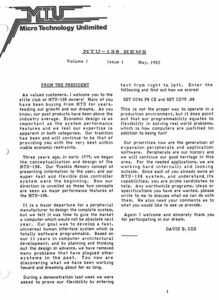 |
MTU News V1.1 1982-05 |
 |
MTU News V1.2 Q3 1982 |
 |
MTU News V1.3 Q1 1983 |
 |
MTU News V1.4 Q2 1983 |
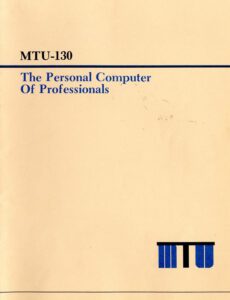 |
MTU-130 The Personal Computer of Professionals |
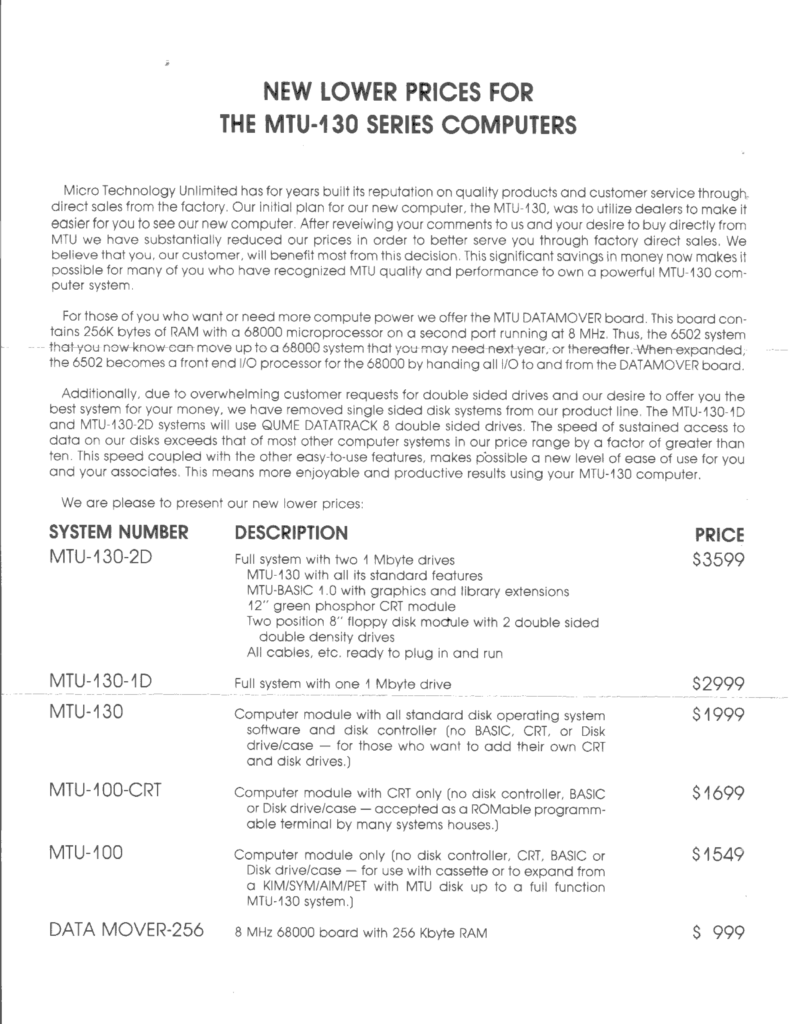

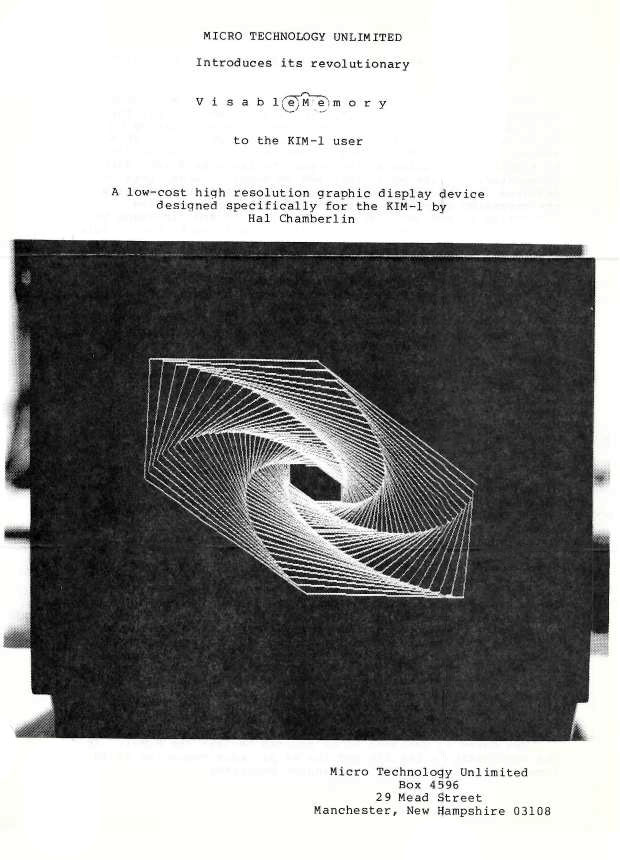











A passive card cage and 4 -slot bus for KIM-1, SYM-1, AIM 65 and PET Commodore.

Note that the KIM/MTU bus is still in use in the replica boards series designed by Eduardo Casino, see his repository here for buffered and an unbuffered version.




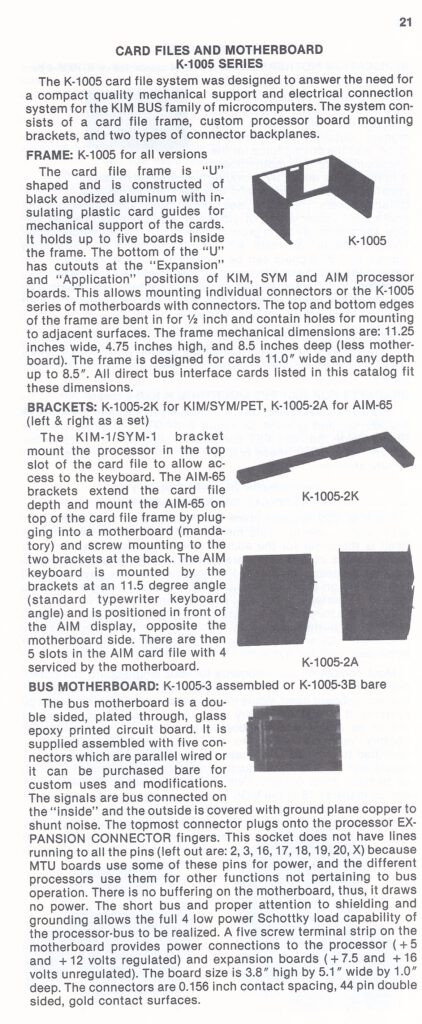

 |
MTU K-1005 Card File and 5 slot Motherboard using KIM/MTU bus |
All MTU expansions, be it card cages with motherboards, memory, video, floppy disk cards use the MTU/KIM-1 bus.




PRINCIPLES OF OPERATION
Actually there is not much theory behind the operation of 5 edge connectors, 44 parallel wires and a terminal strip. What can be discussed however is the philosophy behind the K-1005 series of card files and its associated KIM/MTU bus. The Commodore KIM-1 single-board microcomputer was first released in 1976 and is the grandparent of the Synertek SYM-1 (formerly the VIM-1) and Rockwell AIM-65 micro-computers. Even the Commodore PET shows some KIM-1 influence. These processors cover the vast majority of 6502 based systems in use today and are the ones supported most vigorously by MTU.
WHY THE KIM BUS?
The original KIM-1 was a well thought-out product that hit on just the right tradeoff between system resources and selling price. Some amazing things have been done in its 1K memory such as the first generally available microcomputer chess program, the first 4 voice all software music synthesis program, Tiny BASIC, and others. However at some point every system needs to be expanded and the KIM and its relatives are no exception.
Commodore’s answer for expansion was the KIM-4 expansion bus and KIM-3 memory board. Independent manufacturers introduced similar expansion bus boards while others offered expansion systems based on the Altair (S-100) bus. The S-100 bus adapters were more successful because there was a multitude of expansion boards from which to choose. One pitfall in the S-100 technique is that not all S-100 boards would work properly with 6502 timing signals. The main common fault with the mechanical implementation of these products is their open-air construction which offers little protection for the boards and eliminates portability.
MTU’s first KIM expansion product was the K-1008 Visible Memory. The idea behind the VM was to have a board at the price of a plain 8K memory which would also show a high resolution video image. The goal was to capture both the KIM add-on memory and video display market with a single product. In deciding how it should connect to the KIM we had several factors to consider. First, it seemed like a poor idea to produce a board to plug into a bus (KIM-4) that few potential customers had. On the other hand an S-100 environment would have prohibited our use of 6502 timing properties to produce a totally transparent memory and snow-free display. In the final analysis it seemed desirable to produce a board that re-quired no motherboard or bus at all to connect and thus be available at a much lower “installed” price. The logical conclusion was simply direct parallel connection to the KIM-1 Expansion connector!
The KIM BUS, which is the signals on the KIM’s expansion edge connector, for the most part uses the actual signals from the 6502 microcomputer itself. Further-more the SYM-1 and AIM-65 Expansion connector busses are for practical purposes identical to the KIM-1 bus. The combined number of these processors sold makes the KIM bus one of the most widely used and to date has suffered less from compatibility problems than any other multi-vendor personal computer bus structure.
We have since designed and manufactured 4 additional expansion boards that may be used alone in the same manner. In order to support those customers who wish to use several of our expansion boards, we designed the K-1005 motherboard/card file which is simply a convenient method of connecting several boards to the processor’s expansion connector along with the necessary mechanical support provisions.
PLAIN OR BUFFERED?
Probably the most frequently asked question regarding the K-1005 is “Why is the bus not buffered?”. The basic answer is that buffering is not needed for only 4 expansion boards. The next question then is “Why not buffer it anyway to reduce microprocessor loading, provide noise immunity, and improve signal rise times?”. The answer to that is somewhat more technical but in a nutshell buffering has some of its own problems and it is not necessarily true that it improves system operating margins when the unbuffered equivalent does not violate any loading rules.
The KIM bus address and data lines are simply the corresponding microprocessor busses brought out to edge fingers. The various control signals (PHASE 2 and READ/WRITE) are indeed buffered by TTL gates on the processor board. The unbuffered address and data lines are rated by the microprocessor manufacturer to drive 1.7MA of DC loading and 170pF of capacitance. This figures out to 5 low power Schottky TTL (74LS series) inputs (MOS inputs such as to memory IC’s have no DC load) and about 35 circuit connections at 5pF per connection. The processor board itself uses one low power Schottky load and about a dozen connections (more connections on SYM and AIM processors). This leaves 4 low power Schottky inputs and over a dozen connections for the external bus which is adequate for implementing a 4 slot expansion bus. This is the main reason the K-1005 has 5 slots including processor.
Probably the most misunderstood aspect of buffering is noise generation and immunity. In theory low impedance TTL or TRI-STATE bus drivers should be able to “short out” noise spikes much better than high impedance MOS outputs can. This may be true, but in practice TTL or high power TRI-STATE bus buffers generate so much noise when they switch that almost nothing can absorb it. The problem is most acute in large systems (such as minicomputers and S-100 computers) where as many as 24 buffers with 100MA surge capability and nanosecond rise times can switch simultaneously thus placing a 2.5 amp reaction current surge through the GROUND leads of the bus. It is not unusual to see over a half volt differential in GROUND voltages between driving and receiving boards in such a system. In practice such spikes interfere with the bus CONTROL signals which results in unpredictable occurrances such as spurious writing into memory or falsely triggering an I/O device. Seldom are address and data bus signals themselves read wrong even though they cause the noise because they are ignored while changing (under the direction of control signals). indicate that all changing must have ended and the data be stable at it’s “0” or “1” state. It is instructive to note that minicomputer busses (such as the DEC UNIBUS and the NOVA bus) specify the use of filter and delay circuits on control signal lines received by interface boards. In addition, these systems typically have multilayer backplanes with ground planes to shield and shunt noise.
With unbuffered MOS and low power (8 MA) 74LS TTL bus drivers, such noise is almost completely absent. The author has had considerable experience in designing and troubleshooting bus systems and the unbuffered KIM bus is among the quietest encountered. With respect to rise time, 8MA is sufficient to swing 170PF (which is actually a rather heavy bus load) from logic zero to one or vice-versa within 65NS which is quite adequate for 1MHz 6502 operation. Note that this time has already been factored into the 6502 timing specifications. Remember also that bus buffers do have their own propagation delay times.
KIM BUS -VS- KIM/MTU BUS
As the reader may have guessed, the bus implemented on the K—1005 motherboard is not strictly a KIM—I bus. If it were, all 44 lines would be run strictly parallel up and down the board. The MTU modification amounts to assigning the top slot to the CPU (except for the PET version where all slots are equivalent) and not connecting some of the pins to the expansion bus below. This then frees up several lines on the expansion bus for other functions that do not relate to the CPU or computer bus operation,
Two of the pins are used to provide unregulated +8 and +16 volt power to the expansion boards, which the CPU does not use, Two more pins are used for the DECODE ENABLE and VECTOR FETCH signals that KIM-I systems require (unnecessary for AIM—65 and SYM—1). An additional three pins are used (in PET systems only) to carry separated Vertical, Horizontal and Video signals to a separate sync video monitor. Finally there is one spare set aside for future use. The following page lists the signals of each processor and those of the KIM/MTU bus used on the K-1005.
In providing these expansion bus signals, some signals from the CPU are not available on the bus, The most significant of these are READY and PHASE 1, PHASE 1 is equivalent to PHASE 2 the inverse of PHASE 2 which is available on the bus, Modern memories are fast enough so that wait states are not needed, thus the •READY signal. is of no use, Besides, the 6502 will not wait during a write cycle anyway.
Now with the manuals scanned by Clayton Seale, thanks!

In Bad König, Westenwald, Germany, Matthias Schmitt and his wife have developed a museum dedicated to Technik called TECMUMAS. Mostly retro computers from the early days to the nineteens.
Here some photos of my visit in June 2025, when I was given the opportunity to see and photograph MOS Technology KIM-4 and KIM-5 devices and the Synertek MDT 1000.
Besides those systems TECMUMAS is home to about 1400 computers and what comes with it: manuals, books, monitors and more.
The museum has a large room to display a part of the collection, regularly refreshed with objects of the collection absed upon a theme.

See the page with photos of TECMUMAS. And the following updates to pages:
Synertek MDT 1000
KIM Brochure
KIM-1 Rev F image
KIM-4
KIM-5

During a visit to the TECMUMAS museum I found a Synertek MDT 1000 development system. Only known to me from an advertisement in Electronics 1980. Matthias allowed me to make detailed photos!





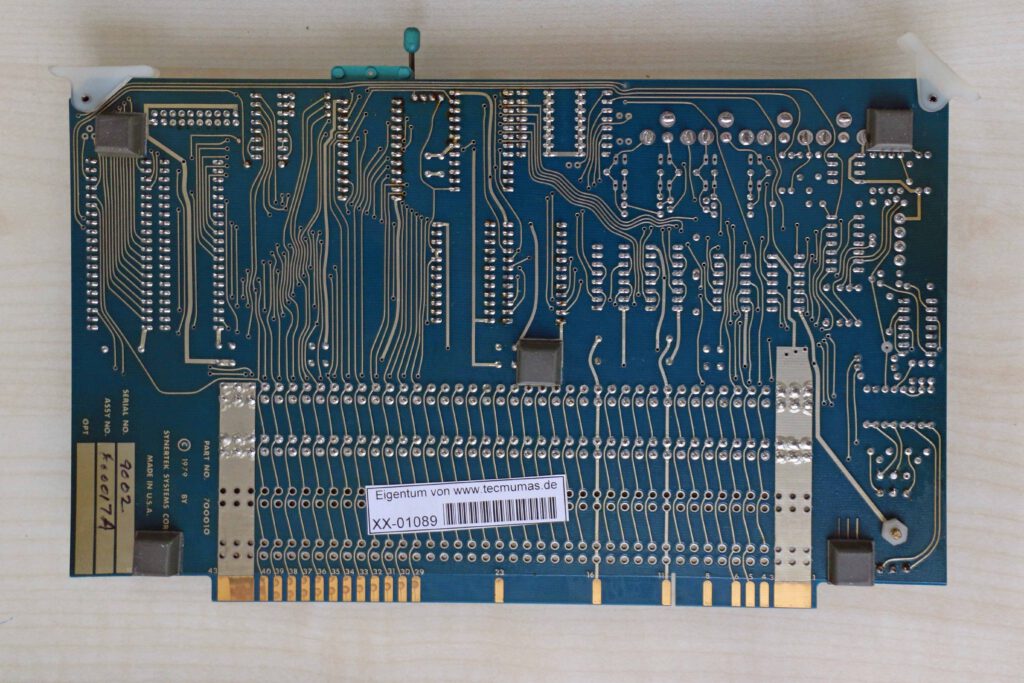






Some pages from Synertek databooks refer to parts of the MDT 1000 system




Coming soon scan of the MDT 1000 manual, TECMUMAS Matthias will do that soon!
New information added to the Synertek pages:
Images of Synertek objects in my collection
SYM-1s, KTM/2-80, expansions, books, manuals, ICs
SYM-1 Manuals
VIM-1 Reference Manual May 1978 scanned
Circuit Diagram SYM-1 high resolution high quality scanned
SYM-1 Technical Notes
Manual of KTM-2 and KTM-2/80February 1981 , high quality
SYM-2 manual, photos, source of monitor and ROM dump
